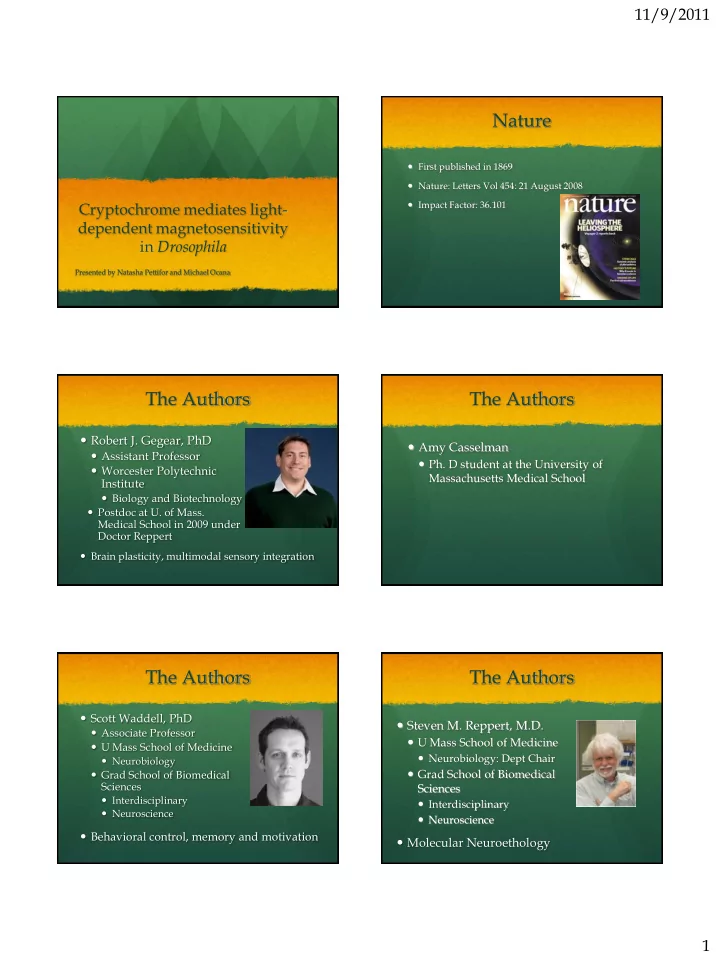

11/9/2011 Nature First published in 1869 Nature: Letters Vol 454: 21 August 2008 Cryptochrome mediates light- Impact Factor: 36.101 dependent magnetosensitivity in Drosophila Presented by Natasha Pettifor and Michael Ocana The Authors The Authors Robert J. Gegear, PhD Amy Casselman Assistant Professor Ph. D student at the University of Worcester Polytechnic Massachusetts Medical School Institute Biology and Biotechnology Postdoc at U. of Mass. Medical School in 2009 under Doctor Reppert Brain plasticity, multimodal sensory integration The Authors The Authors Scott Waddell, PhD Steven M. Reppert, M.D. Associate Professor U Mass School of Medicine U Mass School of Medicine Neurobiology: Dept Chair Neurobiology Grad School of Biomedical Grad School of Biomedical Sciences Sciences Interdisciplinary Interdisciplinary Neuroscience Neuroscience Behavioral control, memory and motivation Molecular Neuroethology 1
11/9/2011 Magnetic Fields & the Overview Geomagnetic Field. Briefly: magnetic fields and magnetosensitivity What is Cry? Why is it special? Current paper – proof of Cry as a magnetoreceptor? Moving electric fields: vectors with direction and magnitude Geomagnetic fields: caused by Earth ’ s molten interior. Weak: ~0.5 Gauss Magnetoreception: What is magnetoreception? 3 forms? Electromagnetic induction by the Earth ’ s magnetic The ability of an animal to detect (geo)magnetic fields field Generally accepted to be used by a number of both vertebrate and invertebrate species Magnetite-based process Chemical-based reactions …? Cryptochrome: photoreceptor… What is Cryptochrome? (Cry) and magnetorecptor? Blue-light sensitive flavoprotein How can one protein do both things? Involved in circadian rhythms Possibility : free-radicals, spin states & rxn products Thought Trp-mediated Cryptochrome or Cry has two forms …but probably not Cry1 – Drosophila -like Cry Cry2 – Vertebrate-like Cry Proposed alternative: Both present in some insects (e.g. the monarch) flavin transfers an electron to an unknown substrate. Only Cry1 present in Drosophila The radical pairs are then Focus of the current paper generated from this. Only Cry2 present in vertebrates 2
11/9/2011 Cryptochrome mediates light-dependent Cryptochrome mediates light-dependent magnetosensitivity in Drosophila magnetosensitivity in Drosophila Purpose: study the potential chemical basis of Experimental setup: magnetoreception, especially the role of Cryptochrome Upper – Training Lower – Testing Drosophila only posses a single type of this protein, Cry 14 , which has a narrow activation range, peaking at “ Preference index 350-400 nm and plateuing at 430-450 nm value ” calculated Based on proportion of flies on magnetic field side of T-port Does Cry functionality depend on Naïve flies: strain comparison specific wavelengths of light? Yes. Canton-S strains had most profound response to field Exhibited naïve avoidance Black bars: trained flies White bars: naïve flies How do we know it ’ s wavelength Is Cry required for this response? and not irradiance? What is irradiance? In cry 0 flies, the cry sequence was replaced completely (Black is Cry 01, cry 02 and cry 03 were cry 0 backcrossed onto w 1118 trained, white is In cry b flies, a point mutation results in missense naïve) w 1118 flies used as controls – all had same background Irradiance levels: w 1118 flies had a naïve lower in blue light preference for the Low-intensity light: magnetic field effect of training remains Wavelength-dependent 3
11/9/2011 Mutated Cry: naïve responses Mutated Cry: trained responses Flies homozygous for Controls trained to like the Cry 0 mutation failed the field even more to show naïve response Cry 01 mutants can ’ t be Heterozygotes favored trained the magnetic field Heterozygous Homozygous Trained and naïve responses of Cry and the circadian rhythm hetero- and homozygotes The day-night cycle is regulated by the regular activation and inactivation of certain proteins over the day Light acts as a major trigger to this cycle Besides from its photosensitive functions, Cry also serves as a transcriptional regulator for some of these proteins Homozygous Transheterozygous Heterozygous Heterozygous Conclusions Cry and the circadian rhythm Drosophila can respond to a local magnetic field Naïve reaction varies by strain This response requires at least one copy of Cry Disruption of circadian rhythm does not disrupt magnetic sensing ability Solid behavioral assay for chemical- based magnetosensitivity (?... Do you agree?) Many questions remain… 4
Recommend
More recommend